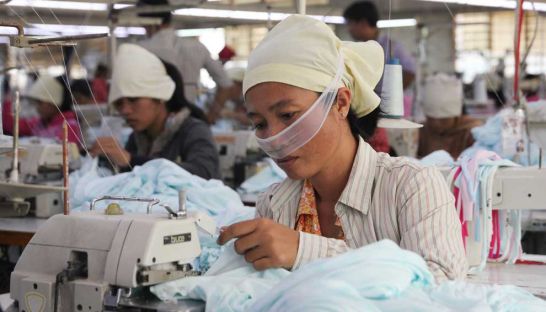Factories to lose millions
Factories to lose millions
The economic fallout from garment worker protests and the industry’s response is expected to cost the key sector millions of dollars while tarnishing the country’s reputation among international buyers, interviews with suppliers and figures from previous periods of labour unrest show.

Disputes over wages came to a head yesterday when the Garment Manufacturers Association in Cambodia (GMAC) issued a letter to its 400-plus members urging them to cease operations for a week amidescalating protests.
The letter, which said the shutdown would avoid confrontations, came two days after unions called for a strike in response to the Ministry of Labour’s announcement that wages in the garment sector would rise to $95 in 2014, rather than the immediate hike to $160 that workers demanded.
A coalition of garment and textile unions predicts that more than 200,000 workers from 300 factories will eventually join the strike action.
While the exact number of garment manufacturers opting to follow GMAC’s recommendations remains unclear, Ken Loo, secretary general for the association, said he expects there to be severe economic consequences.
“Well, duh. Of course there will be a great effect on the economy. [But] we will not be able to tell the exact figure until the strikes are over,” he said. “The number of operators deciding to close is also unknown; however, it is easy to say that many will close operations.”
Similar scenes in September 2010 saw an estimated 160,000 garment workers strike for three days over wage increases. The 2010 strikes cost GMAC members in excess of $15 million in lost or delayed orders, lost production, additional transport costs and discounts to buyers, according to a report published by the Cambodian Centre for Human Rights later that year.
Senior officer at GMAC Cheat Khemara cited factory closures, cancelled orders and waning buyer confidence in the Cambodian garments sector as all-too-real consequences of demonstrations. “The effects are serious and such a risky situation between workers and manufacturers makes investors worry,” he said.
Khemara warned that smaller, locally owned garment makers were at much higher risk of going out of business than larger manufacturers.
Mao Chhevsong, administrative manager at Wing Star Shoes, which employs more than 5,000 workers, said his company had closed its doors in the afternoon shift yesterday after receiving the GMAC letter.
He said his factory stands to lose $30,000 every day it ceases operations, just on administration fees.
“That does not include the impact of missing buyer deadlines and the penalties associated with that,” he said. “My boss is very concerned about this situation because his clients [buyers] may cancel their order as they also worry about missing deadlines.”
Kang Nam Shik, the owner of Korean company Injae Garment Co in Phnom Penh, closed his factory yesterday after hundreds of union protesters gathered in front of the factory. He said he would aim to reopen today depending on worker safety.
“I informed my buyers that we are closing for the day, maybe two days . . . [but] many buyers will leave Cambodia because of this uncertainty.”
On the other end of the scale, Nhim Bunrith, the owner of Apsara Garment Co Ltd, said he would not shut down operations despite the industry tensions, citing rapidly reducing profit margins.
In any case, he said, “if you are a buyer, would you want to place an order during turbulent times like these?”
A spokesman for Swedish clothes maker H&M, a prominent buyer of garments made in Cambodia, declined to comment, but said the company is monitoring the situation.
Cambodia garment trade exports totalled more than $5.07 billion in the first 11 months of 2013, equalling an average daily export value of $17.4 million, excluding Sundays and not counting public holidays.
The Kingdom’s export total represents a 22 per cent increase on the same period in 2012.
phnompenh post














